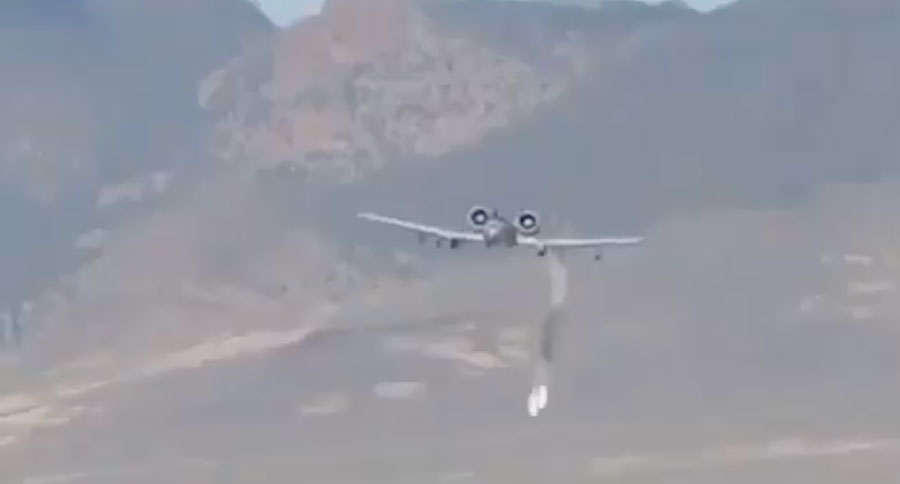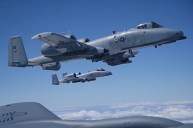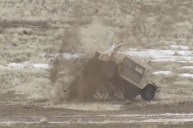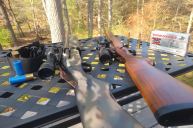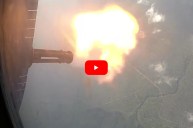One simply does not mess with the A-10 Thunderbolt and get away with it.
Call her the A-10 Thunderbolt, or the more affectionate A-10 Warthog, but the U.S. Air Force close air support avenger will take a beating and still find a way to shower you with her low-altitude, armor-piercing ammo.
The A-10 is one of the most revered pieces of equipment that our fighting men and women have at their disposal, and its track record proves it. The 30 mm GAU-8/A cannon that sits in the front of the A-10, with the barrel protruding from the nose, is one of the heaviest automatic cannons ever mounted on an aircraft.
Since the pilots are protected by titanium armor (which also protects parts of the flight-control system), the A-10 can linger longer in the battle zone in all kinds of conditions including low visibility and darkness.
The A-10 Thunderbolt has earned its reputation thanks to the bravery of her pilots and her performance above the battlefield.
We're proud to give a little respect back to those who have served our great country and share a few of the reasons why the A-10 Warthog is an aircraft that should never be taken lightly.
1. Armament
Here's the total count: a 30 mm GAU-8/A cannon, up to 16,000 pounds of mixed ordnance (on eight under-wing and three under-fuselage pylon stations), a 500-pound Mk-82 and 2,000-pound Mk-84 series low/high drag bombs, incendiary cluster bombs, effects munitions, mine dispensing munitions, an AGM-65 Maverick and AIM-9 Sidewinder missiles, and a Gatling gun that is specifically designed to fire highly explosive incendiary and armor-piercing depleted uranium rounds at a rate of 3,900 rounds per minute. That's a serious aircraft with a bad attitude. And you want to shoot at this bad beast?
Good luck with that.
2. Survivability
The A-10 has a honeycomb panel design that makes up the leading edges of the wing and tail, making them more resistant to battle damage. Interestingly, the front landing gear retracts under the wings while still sticking somewhat out of the fuselage giving the Warthog a way to touch down with its landing gear up.
This aircraft can survive multiple direct hits from armor-piercing and high-explosive projectiles, while its self-sealing fuel cells are protected by internal and external foam. Pilots during campaigns such as the Gulf War have been known to fly the A-10 tank killer back to base with some incredible damage!
3. Range
At around 2,580 miles, the Warthog's flight range could get you from New York City to Los Angeles, California. Thanks to two General Electric TF34-GE-100 turbofan engines, the aircraft can achieve about 450 mph (or about Mach .75), making the Thunderbolt fast enough to be ultra deadly
4. Support
Because the A-10 was specifically designed for close air support mission, its large and varied ordnance, long loiter time above the battlefield, accurate weapons delivery, and unfriendly field capability are more than well-developed to be at the forefront of the ground forces around it.
As the U.S. Airforce says, "the Low-Altitude Safety and Targeting Enhancement (LASTE) upgrade provided computerized weapon-aiming equipment, an autopilot, and a ground-collision warning system," which "includes multi-band communications; Global Positioning System and inertial navigations systems; infrared and electronic countermeasures against air-to-air and air-to-surface threats."
In other words, try to shoot at our ground troops and we will not only shoot back, but unleash hell on you exactly where you stand.
5. Grit
A-10 pilots have night vision capability to conduct missions during any hour after dark. The A-10 was also designed with a fast maintenance turnaround time in mind to keep it on the battlefield.
Things like damaged wing skins that can be replaced in the field, the cannon creating so much smoke while it's being fired that it looks like a forest fire, and a Gatling gun that fires rounds the size of beer bottles makes the Warthog deserve its moniker: "The Cross of Death."
Certainly, the most important thing to remember is the pilots who fly these winged wonders and the ground crews that maintain them. Our fighting men and women are the real heroes and the A-10 Thunderbolt is just another tool in the fight for freedom, and a tool that works quite well, thank you.
Between the maneuverability and the survivability the A-10 fleet fighter squadron has taken on Operation Enduring Freedom, Desert Storm, and ISIS wherever they may be making it one of our best weapons in the fight for freedom around the globe.
Looking for a little more? Follow my webpage, or on Facebook and Twitter.
NEXT: M1 ABRAMS TANKS ARE NOT TO BE MESSED WITH
WATCH
